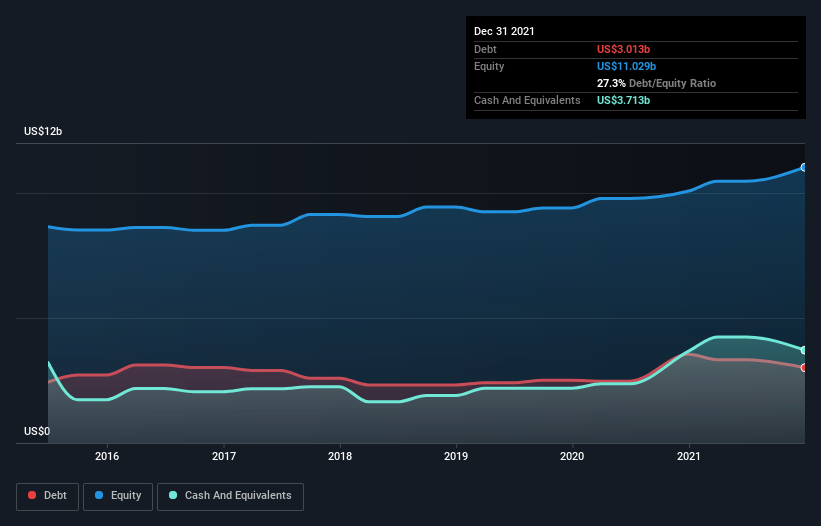- United Kingdom
- /
- Metals and Mining
- /
- LSE:ANTO
We Think Antofagasta (LON:ANTO) Can Manage Its Debt With Ease

The external fund manager backed by Berkshire Hathaway's Charlie Munger, Li Lu, makes no bones about it when he says 'The biggest investment risk is not the volatility of prices, but whether you will suffer a permanent loss of capital.' When we think about how risky a company is, we always like to look at its use of debt, since debt overload can lead to ruin. We can see that Antofagasta plc (LON:ANTO) does use debt in its business. But is this debt a concern to shareholders?
Why Does Debt Bring Risk?
Generally speaking, debt only becomes a real problem when a company can't easily pay it off, either by raising capital or with its own cash flow. Ultimately, if the company can't fulfill its legal obligations to repay debt, shareholders could walk away with nothing. However, a more frequent (but still costly) occurrence is where a company must issue shares at bargain-basement prices, permanently diluting shareholders, just to shore up its balance sheet. Of course, plenty of companies use debt to fund growth, without any negative consequences. When we examine debt levels, we first consider both cash and debt levels, together.
View our latest analysis for Antofagasta
What Is Antofagasta's Net Debt?
You can click the graphic below for the historical numbers, but it shows that Antofagasta had US$3.01b of debt in December 2021, down from US$3.55b, one year before. But on the other hand it also has US$3.71b in cash, leading to a US$700.3m net cash position.

How Healthy Is Antofagasta's Balance Sheet?
We can see from the most recent balance sheet that Antofagasta had liabilities of US$1.57b falling due within a year, and liabilities of US$4.68b due beyond that. Offsetting this, it had US$3.71b in cash and US$1.16b in receivables that were due within 12 months. So its liabilities total US$1.38b more than the combination of its cash and short-term receivables.
Of course, Antofagasta has a titanic market capitalization of US$22.1b, so these liabilities are probably manageable. Having said that, it's clear that we should continue to monitor its balance sheet, lest it change for the worse. While it does have liabilities worth noting, Antofagasta also has more cash than debt, so we're pretty confident it can manage its debt safely.
Even more impressive was the fact that Antofagasta grew its EBIT by 117% over twelve months. That boost will make it even easier to pay down debt going forward. There's no doubt that we learn most about debt from the balance sheet. But ultimately the future profitability of the business will decide if Antofagasta can strengthen its balance sheet over time. So if you want to see what the professionals think, you might find this free report on analyst profit forecasts to be interesting.
But our final consideration is also important, because a company cannot pay debt with paper profits; it needs cold hard cash. Antofagasta may have net cash on the balance sheet, but it is still interesting to look at how well the business converts its earnings before interest and tax (EBIT) to free cash flow, because that will influence both its need for, and its capacity to manage debt. Over the most recent three years, Antofagasta recorded free cash flow worth 57% of its EBIT, which is around normal, given free cash flow excludes interest and tax. This cold hard cash means it can reduce its debt when it wants to.
Summing up
We could understand if investors are concerned about Antofagasta's liabilities, but we can be reassured by the fact it has has net cash of US$700.3m. And it impressed us with its EBIT growth of 117% over the last year. So we don't think Antofagasta's use of debt is risky. The balance sheet is clearly the area to focus on when you are analysing debt. But ultimately, every company can contain risks that exist outside of the balance sheet. We've identified 2 warning signs with Antofagasta , and understanding them should be part of your investment process.
Of course, if you're the type of investor who prefers buying stocks without the burden of debt, then don't hesitate to discover our exclusive list of net cash growth stocks, today.
New: Manage All Your Stock Portfolios in One Place
We've created the ultimate portfolio companion for stock investors, and it's free.
• Connect an unlimited number of Portfolios and see your total in one currency
• Be alerted to new Warning Signs or Risks via email or mobile
• Track the Fair Value of your stocks
Have feedback on this article? Concerned about the content? Get in touch with us directly. Alternatively, email editorial-team (at) simplywallst.com.
This article by Simply Wall St is general in nature. We provide commentary based on historical data and analyst forecasts only using an unbiased methodology and our articles are not intended to be financial advice. It does not constitute a recommendation to buy or sell any stock, and does not take account of your objectives, or your financial situation. We aim to bring you long-term focused analysis driven by fundamental data. Note that our analysis may not factor in the latest price-sensitive company announcements or qualitative material. Simply Wall St has no position in any stocks mentioned.
About LSE:ANTO
Adequate balance sheet with moderate growth potential.
Similar Companies
Market Insights
Community Narratives



